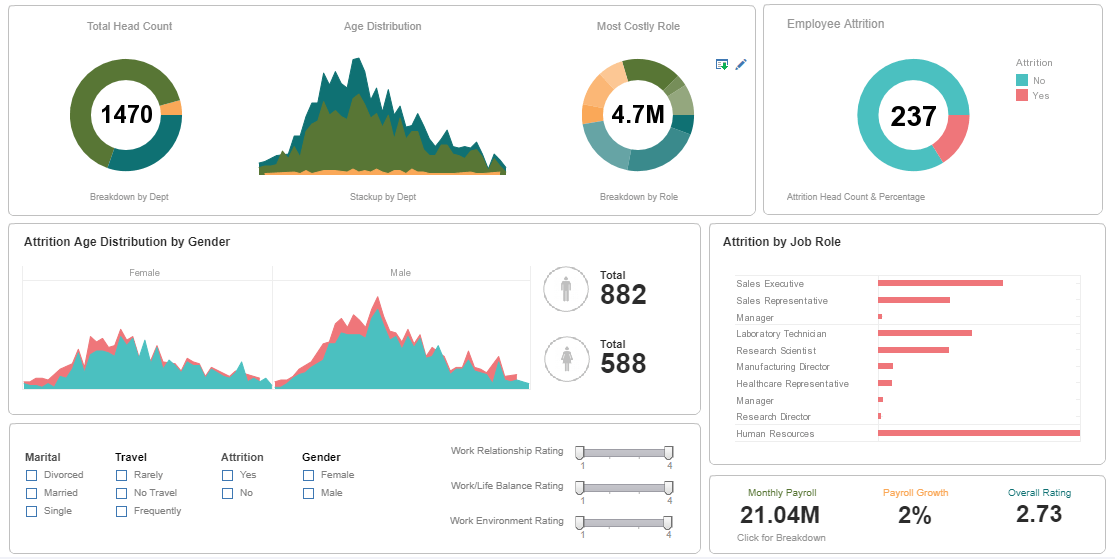The Role of Data Analytics in Building a High-Performance Workforce
Nowadays, organizations face the ongoing challenge of optimizing their workforce to achieve peak performance.
The key to unlocking the full potential of any organization lies in leveraging employee data at scale and using powerful data analytics tools to make informed decisions about talent acquisition, development, and retention.
| #1 Ranking: Read how InetSoft was rated #1 for user adoption in G2's user survey-based index | Read More |
How data analytics is transforming the recruiting processes
Data analytics in recruiting is the application of data-driven tools and insights to enhance the efficacy and efficiency of the recruitment process. HR professionals may improve applicant sourcing, make well-informed decisions, and find top talent more quickly by using data. Here are some examples of how data analytics is changing recruitment:
- Sourcing and talent acquisition: With data analytics, recruiters can identify the most effective sourcing channels. This way, they can focus their efforts on the channels that yield the best results according to historical data.
- Candidate screening: Candidate data and employee APIs allow recruiters to identify patterns and features that are common among successful employees. This data-driven approach encourages more objective decisions during the selection process. This also helps to reduce bias and improve the quality of hires.
- Predictive analytics: Data analytics can predict candidate performance and job fit based on historical data and assessment scores. This helps recruiters prioritize candidates who are more likely to succeed in a particular role.
- Diversity and Inclusion: Data analytics can help organizations track diversity metrics during the recruitment process, ensuring that diverse candidates have equal opportunities. It allows recruiters to identify potential bias and implement measures to foster an inclusive workplace.
- Identifying gaps in skills and training: Data analytics provides organizations with valuable insights into their employees' skill sets and competencies. By analyzing performance data, organizations can identify skills gaps within their workforce. This information enables HR departments to develop targeted training and development programs, fostering continuous improvement and upskilling, leading to a more capable and high-performing workforce.
- Performance evaluation and productivity improvement: Data analytics empowers businesses to measure employee performance more objectively. Through the analysis of key performance indicators (KPIs) and productivity metrics, organizations can provide valuable feedback to their employees. This data-driven approach ensures that employees receive constructive evaluations and can identify areas for growth, ultimately leading to improved performance.
 |
View a 2-minute demonstration of InetSoft's easy, agile, and robust BI software. |
The main aspects that make a high-performance workforce
Research conducted by Accenture showed that by using the combination of data, technology, and people, an organization can increase its productivity by up to 11%. A high-performing workforce boasts having the following aspects:
- Clear goals and performance feedback: Clear expectations and goals are set for each employee, aligning their individual objectives with the broader organizational objectives. Regular and constructive performance feedback and evaluations help employees understand their strengths and areas for improvement.
- Skilled employees: Hiring and developing employees with the right skills and competencies are vital for a high-performing workforce. Businesses should invest in the professional development of their employees to keep up with current industry trends and best practices.
- Strong leadership: Effective leadership is essential for fostering a high-performing workforce. Strong leaders provide guidance, support, and motivation to employees, creating a positive work environment and driving employee engagement.
- Collaborative culture: A culture that promotes teamwork, open communication, and collaboration enhances productivity and creativity. High-performing workforces thrive in environments where employees feel comfortable sharing ideas and working together towards common goals.
- Employee empowerment: Empowered employees have a sense of ownership over their work and decision-making. Empowerment leads to increased motivation and accountability, driving performance improvement.
 |
View live interactive examples in InetSoft's dashboard and visualization gallery. |
The advantages of using data analytics in recruitment
Using data analytics in recruitment offers numerous advantages that significantly improve the effectiveness of the whole talent acquisition process. Here are some key benefits:
Reduced time-to-hire and streamlined process
The time of the hiring cycle can be reduced by 60% through the effective use of optimization. By analyzing the recruitment data, organizations can identify bottlenecks and inefficiencies in the hiring process. Streamlining the process based on data insights leads to a faster time-to-hire and helps secure top talent before competitors do.
Improved hire quality
Data analytics allows recruiters to evaluate candidate attributes, skills, and qualifications objectively. By matching candidate profiles with successful employees' data, organizations can hire candidates with a higher likelihood of success in the role.
More DE&I efforts
Data analytics helps in tracking diversity metrics and identifying areas for improvement. By analyzing candidate demographics and hiring outcomes, organizations can implement strategies to foster a more diverse and inclusive workforce. According to Gartner, pushback to DEI efforts can decrease workforce engagement and trust.
 |
Read the top 10 reasons for selecting InetSoft as your BI partner. |
Enhanced candidate experience
Analyzing candidate interactions and feedback provides insights into the candidate experience. Improving the candidate experience positively impacts an organization's employer brand and attracts top talent.
Continuous improvement that leads to competitive advantage
Organizations that leverage data analytics in recruitment gain a competitive advantage in the talent market. They can identify trends, market demands, and competitor hiring strategies, making more strategic decisions. Recruiters can track the performance of hires and continuously refine the process for better outcomes. Regularly analyzing employee data allows organizations to evaluate the effectiveness of their recruitment strategies and make data-driven decisions for continuous improvement.
Effective talent pool management and risk mitigation
Data analytics can help identify red flags or potential risks associated with certain candidates, such as high turnover rates or low performance in previous roles. By creating and maintaining talent pools, recruiters can engage with potential candidates for future roles. Organizations can create and maintain talent pools of potential candidates for future roles. Recruiters can nurture relationships with candidates who are a good fit but might not be immediately hired.


